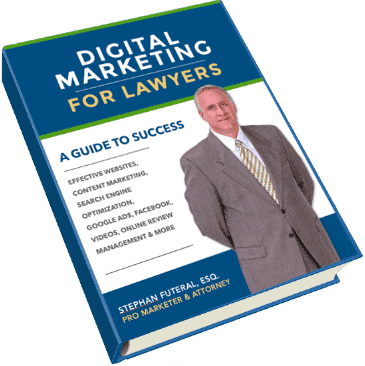As SEO and online marketing experts for lawyers websites, we emphasize the importance of having quality content on a firm’s website. By now, you’ve probably read or heard that “content is king” when it comes to any law firm’s online marketing strategy. In this article, I’m not going to preach to anyone about content except to say this: content is what draws traffic to your website, and quality content is what converts a site visitor into a firm lead. If you need proof, then check out our lawyer SEO case study where traffic to my law firm’s website increased over 300% in one year (approximately 15,000 visitors each month) and new client intakes increased 94%! This increase was directly attributable to CONTENT. Having said that, pushing out content isn’t enough; the content must be quality. If you follow the 3 tips below, you will create quality content that converts site visitors into new clients.
1. Don’t Write Like a Lawyer
Writing like a lawyer completely defeats the purpose of content marketing to potential clients. Clients don’t want a lawyer who talks over their heads or down to them. Clients don’t want to learn they law; they want to understand how it impacts their situation. Consider the following blog excerpt concerning jurisdiction in South Carolina for a divorce:
Two areas of family law do not require personal jurisdiction over the Defendant but only require in rem jurisdiction. Those areas are divorce [S.C. Code Ann. § 20-3-30] and child custody [S.C. Code Ann. § 63-15-330]. For these matters, a Plaintiff can file the action in South Carolina even if there is no personal jurisdiction over the Defendant. The Plaintiff, and, in child custody cases, the child, still need to meet jurisdictional requirements that are often based on residency to pursue divorce or custody cases here. . . . In Kulko v. Superior Court of California, 436 U.S. 84, 91 (1978), the United States Supreme Court held that even though California had jurisdiction to establish child custody it lacked jurisdiction over a non-resident father to establish child support.
The passage above was written as though it were a legal brief. Most readers, unless they are lawyers, won’t have a clue regarding terms such as “in rem” jurisdiction vs. “personal” jurisdiction. Now consider the passage below and ask yourself whether this excerpt does a better job of helping a reader understand the issue of jurisdiction:
Under South Carolina law, if one spouse lives in another state, the other spouse must have lived in South Carolina for a year to file for a divorce here. The family court has jurisdiction over custody and support issues when a child has lived in South Carolina for at least six months.
The second passage is concise, written in plain English, and will help any reader regardless of they’re sophisticated understand the issue of jurisdiction. Overall, the hallmark off any great blog post on the law is a post that makes complex concepts simple for the reader to understand.
2. Provide Solutions to Potential Clients’ Problems
To provide solutions to potential clients’ problems, your content must be a RESOURCE. There is a big difference between just using content on your law firm website and whether your law firm website’s content is a resource. Here is what I mean by the difference between “content” and “resource”:
| Content | Resource |
|---|---|
| Provides information | Provides solutions to problems |
| Addresses any question or topic | Address a target audience’s specific needs |
| May be superficial (such as blogging about a recent accident that was in the news) | Reasonably comprehensive (such as blogging about exactly what you should do if you’re in an accident) |
| “I’m a lawyer, so listen to what I have to say about legal issues.” | “We understand you have a legal problem; let us help you solve it.” |
The key thing to remember is to focus on solving problems instead of just saying things. By giving your readers value, you’ll convert site visitors into actual leads.
3. Avoid “Thin” Content
Thin content is content that is low value and unoriginal. Stated another way, thin content are “cookie cutter” pages and posts. Here is what Google has to say about thin content:
One of the most important steps in improving your site’s ranking in Google search results is to ensure that it contains plenty of rich information that includes relevant keywords, used appropriately, that indicate the subject matter of your content.
However, some webmasters attempt to improve their pages’ ranking and attract visitors by creating pages with many words but little or no authentic content. Google will take action against domains that try to rank more highly by just showing scraped or other cookie-cutter pages that don’t add substantial value to users.
As an example of thin content, many lawyers who relied on FindLaw to maintain their websites and fill the sites with content regarding their practices areas saw their traffic levels drop in 2o14 because FindLaw’s content was thin. Essentially, the content was recycled, repackaged, and pushed out across numerous websites. The key here is to create original content that is valuable to your readers.
Final Thoughts
The three best things you can do to successful market content for your law firm’s website is to avoid writing like a lawyer, create content that solves your target audience’s problems, and create original content. Learning how NOT to write like a lawyer can be more difficult than it sounds. My advice is to have someone who isn’t a lawyer read over your content and tell you whether it sounds “lawyerly” and why. As for creating content that is a “resource,” start with a common legal issue, explain the issue, and then provide your insights on how to avoid or solve the issue. For example, if you’re a divorce lawyer, write an article on the 5 biggest mistakes you see your clients making and how to avoid them. Lastly, if you can, try to avoid outsourcing your content. If you must outsource, then check over examples of the vendor’s work to make sure that you aren’t getting “recycled” content that is being used on multiple websites.


